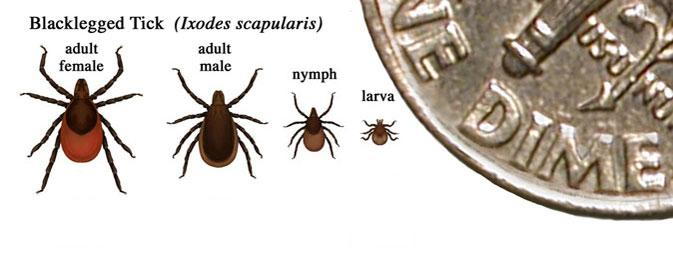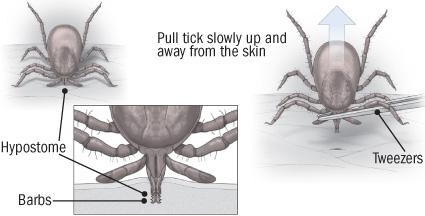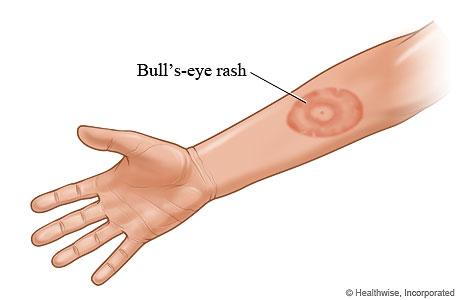- posted: Mar. 07, 2017
We hope that you are having a good week! This week, we want to discuss Lyme disease including the causes, symptoms, and treatment options. As always, check out our tasty recipes and current office happenings.
Causes
Lyme disease is caused by Borrelia burgdorferi and Borrelia mayonii bacteria and is carried primarily by blacklegged or deer ticks. These ticks are no bigger than a poppy seed in their young, nymph stage. According to the CDC, to contract Lyme disease, an infected tick must bite you. The bacteria will enter your skin through the bite and make their way into your bloodstream. Typically, a deer tick must be attached for 36 to 48 hours for the host to contract Lyme disease. This is assuming that the host has a healthy immune system. If you find an attached tick which looks swollen, it may have fed long enough to transmit the bacteria.
Most humans are infected by young nymph ticks because they are difficult to see. Bites from nymph ticks are most common in the spring and summer months. Adult ticks can also transmit Lyme disease bacteria, but they are more likely to be discovered and removed before they have had time to transmit the bacteria because they are easier to spot. Lyme disease cases are most common in the Northeast, Mid-Atlantic, and Upper Midwest of the U.S.

There is mixed evidence stating that there are other means of transmission of Lyme disease. According to the CDC, Lyme disease is only transmitted through tick bites. They state that you can not contract Lyme disease through sexual transmission, from an infected pet, or through blood exposure. However, they have found that the Borrelia burgdorferi and Borrelia mayonii bacteria can live in blood stored for donation.
Some sources have found that if pregnant women are infected, they are capable of passing on Lyme disease to their unborn children. We found an article posted on Caudwell LymeCo Charity stating that there have been 46 cases of congenital Lyme disease to date.
https://caudwelllyme.com/2016/04/22/congenital-lyme-disease/
Again, the CDC states that Lyme disease can not be sexually transmitted. We did find a study published in the January 2014 issue of the Journal of Investigative Medicine, which found that Lyme disease may be sexually transmitted.
https://www.lymedisease.org/lyme-sexual-transmission-2/
Protect Yourself
- Know where to expect ticks. Blacklegged ticks live in moist and humid environments, particularly in and near wooded or grassy areas. To avoid ticks, walk in the center of trails and avoid walking through tall bushes or other vegetation.
- If you have been outdoors, especially if you are on the East Coast, check yourself for ticks. Focus on areas under the arms, in and around the ears, inside the belly button, back of the knees, in and around all head and body hair, between the legs, and around the waist.
- If you do find a tick and remove it within 24 hours, your risk of Lyme disease are low. Remove it gently with a pair of needle nose pliers. Make sure that head of the tick as it may be buried in the skin.

- Be aware if you have an unexpected fever or odd rash. Either of these may be the first signs of Lyme disease, particularly if you’ve been in tick habitat.
- If you live in an area that is a known tick habitat, a tick collar on your pets will prevent them from carrying the tick into your home.
Symptoms
- Arthritis-like pain that spreads throughout the joints, most often in the knees and elbows (can last days to months after infection)
- Migraines (can occur 3-10 days after infection)
- Stiff neck (can occur days to months after infection)
- Body aches (can occur days to months after infection)
- partial paralysis of the face (can last days to months after infection)
- Fever and chills (can occur 3-30 days after infection)
- Persistent fatigue (can last months to years after infection)
- Irregular heart beat (can occur days to weeks after infection)
- Dizziness (can occur days to weeks after infection)
- Shortness of breath (can occur days to weeks after infection)
- Electrical sensations (can last months to years after infection)
- Memory loss (can last months to years after infection)
- Difficulty concentrating and various mental disturbances (can last months to years after infection)
A rash shaped like a bull’s-eye is considered characteristic of Lyme disease. This rash is called erythema migrans, and will not occur in all patients. The CDC estimates that the erythema migrans rash occurs in 70-80% of cases. This rash will spread in the days and weeks following the initial infection. We've included an example of a bull's-eye rash below.

Treatment
In researching natural treatments for Lyme disease, the most common 'treatment' available was to prevent infection within the first 24 hours after the tick bite. As stated above, if you are able to remove an infected tick shortly after the bite, chances of contracting Lyme diesase are very low. The second most common treatment that we found was through dietary intervention. Strengthening your immune system is incredibly important in fighting all disease, including Lyme. We recently sent a newsletter about bolstering your immune system. We've linked it below.
http://rejuvenatewellnesscenter.com/blog/b_76681_boosting_immunity.html
There are far more studies pertaining to conventional treatment methods. It is important to note that these studies may be funded by the drug companies which manufacture the antibiotics. Research is ongoing, however, to continue to find natural forms of treatment for Lyme disease. We've included some of these options below.
Herbal antimicrobials and immune support, coupled with dietary changes and other supportive nutritional supplements have been used to help a patient recover from Lyme disease. An example is to combine the immune-supportive properties with herbal antimicrobials such as colloidal silver, teasel, cats claw, or olive leaf. These anti-microbial treatments are used in combination with a solid nutritional base. Detoxification will likely be required as well.
Hyperbaric oxygen (HBOT) is another treatment which is being implemented in the treatment of Lyme disease as it improves oxygen flow to the cells accelerating cellular healing and regeneration. It also has antimicrobial action as the bugs do not survive well in that high saturation of oxygen. It helps regenerate neurological function, and sweeps the body of other microbes such as viruses and mycoplasma. The trouble is that HBOT is expensive and requires a significant time investment.
CancerTutor.com suggested an alternative treatment for Lyme disease in the form of Electromedicine, a frequency-based treatment.
"There are many different ways to treat Lyme Disease, but it is critical to understand that Lyme Disease is not confined to the bloodstream. The Lyme Disease bacteria can be found in the muscles, perhaps even inside of human cells, and in other parts of the body. That is why electromedicine is used so often in treating Lyme Disease. Electromedicine, can penetrate anywhere in the body, including inside cells and throughout the muscles and brain. To visualize how electricity travels in the body, consider this: if you put an electrode on one side of your body and you put another electrode on the other side of the body, if you could see the current between the two electrodes, it would look like a football. This is why the placement of electrodes is so important. Electricity always follows the path of least resistance, thus it can travel through the bloodstream, the muscles, etc. Electromedicine is clearly the future of treatments for Lyme Disease. This is because the bacteria which causes Lyme Disease is a master at “hiding” in muscles and perhaps even inside of cells."
Recipes
Taco-Stuffed Avocado

Recipe Credit: Paleoleap.com
Ingredients:
- 1/2 lb. ground beef
- 1/2 onion, diced
- 4 avocados, sliced in half and pitted
- 1 bell pepper, thinly diced
- 1 tomato, diced
- 2 tsp. chili powder
- 1/2 tsp. paprika
- 1/4 tsp. garlic powder
- 1/4 tsp. onion powder
- 1/4 tsp. dried oregano
- 1/4 tsp. ground cumin
- 2 green onions, sliced
- Fresh salsa
- Cooking fat
- Sea salt and freshly ground black pepper
Instructions
- Preheat your oven to 400 F.
- In a bowl combine, chili powder, paprika, garlic, onion, oregano, cumin, sea salt, and black pepper.
- Melt cooking fat in a skillet, over high heat, add the onion, and the ground beef.
- Cook until the beef is browned, sprinkle with the spices, and cook stirring until well mixed.
- Place halved avocado on a baking dish.
- Fill each avocado with ground beef, and top with bell pepper, and tomatoes.
- Place the stuffed avocado in the oven and bake for about 10 minutes.
- Serve the avocado topped with green onions, and fresh homemade salsa.
Sweet Potato Breakfast Waffle Sandwich
- 2 large eggs, divided
- 1 small/medium sweet potato, grated
- ¼ tsp cumin
- ⅛ tsp paprika
- ⅛ tsp garlic salt
- 1 tsp oil, plus more for waffle iron and frying pan
- 1 cup kale, chopped
- ½ medium avocado, sliced
- salt & pepper, to taste
- Heat waffle iron and grease well. Set aside.
- In a medium mixing bowl whisk 1 egg (or egg whites). Add in grated sweet potato–should be around a heaping cup–plus seasonings and 1 tsp oil. Mix well until thoroughly combined. Once waffle iron has fully heated, pack in sweet potato hash mixture into iron, covering all of the quadrants. Press waffle iron down gently and allow sweet potato to cook about 4-5 minutes, until lightly golden.
- While the waffle is cooking saute kale in pan with oil on medium heat until slightly crispy, about 3-4 minutes. Fry or scramble egg in same pan (remove kale or keep in, your choice) to personal preference.
- Once sweet potato waffle is ready gently remove with butter knife and transfer to plate. Layer on kale, fried egg, and avocado slices. Finish with salt and pepper if you wish and enjoy!
Locations
6940 South Holly Circle Suite 201
Centennial, CO 80112, US
Office Hours
Our Regular Schedule
8am - 1pm
3pm - 5pm
8am – 1pm
3pm – 7pm
Closed
Closed
8am – 1pm
3pm – 7pm
8am – 2pm
Closed
Closed
Closed
Closed
Closed


